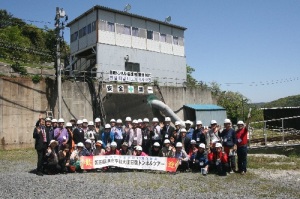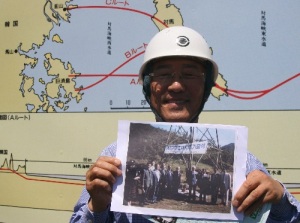■40 experts from Geoje Island, South Korea inspected the Nagoya Shaft in Karatsu

[Photo] 40 visitors from Geoje Peace Ambassadors Council, South Korea
Geoje Island is the planned landing site on the Korean side of the Japan-Korea Tunnel. Located in the South Sea of the Korean Peninsula, just west of Busan, it is the most likely location for the tunnel that has come from Tsushima to emerge above ground and head north across the peninsula to the Eurasian continent. On April 30th, a group of 40 experts and peace ambassadors from Geoje City visited the Nagoya Shaft in Karatsu.
It is customary for Director Okubo to give a 20-minute briefing to confirm the progress and significance of the tunnel concept, followed by a tour to the tip of the 540-meter inclined shaft. However, this time, since the participants were from South Korea, the questions and answers and discussions were heated. ``Busan is the closest to Tsushima in terms of distance. However, the Korean Strait off the coast of Busan has deep water and soft geology. Engineers believe that the area off Geoje Island is suitable for tunnel construction.'' When Director Okubo spoke, there was a big round of applause.
Those who thought, ``Couldn't we still be able to have exchanges without going to the trouble of digging a tunnel?'' said, ``From the perspective of world peace and the unification of the North and South, the Japan-Korea tunnel will play a big role.It's definitely necessary. I started to think so," he said.
Some of the participants brought photos from the groundbreaking ceremony on Geoje Island 30 years ago and passionately said, ``Japan is more advanced in tunnel projects, but we want to move forward with them in South Korea as well.'' . A groundbreaking ceremony was held on Geoje Island in 1988, and four boring surveys were conducted. "Initially, 12 holes were planned to be bored, but in reality only four were made. Unfortunately, we were not able to construct the inclined shaft, but we are preserving the holes that were drilled at that time," he says regarding future progress. He showed enthusiasm.
The now deceased Yasuo Sasa, the first chairman of the Japan-Korea Tunnel Study Group, can be seen in the center with a panel in the visitor area in the background for those who visited with  photos of the groundbreaking ceremony on Geoje Island in 1988.
photos of the groundbreaking ceremony on Geoje Island in 1988.
400 years ago, when Toyotomi Hideyoshi dispatched troops to Korea, Hideyoshi's naval force was defeated by the tortoiseshell ships of General Yi Sun-shin, who became a hero of Korea, in the waters west of Geoje Island, and Hideyoshi's army was defeated with its supply route cut off. It is a historical area that gave rise to the idea of There used to be a naval base led by General Yi Sun-shin in Jinhae, at the back of this island, but now there is a base for the South Korean Navy.
Also, 110 years ago, during the Russo-Japanese War, the Japanese Navy, including the battleship Mikasa led by Vice Admiral Heihachiro Togo, conducted exercises to welcome the Russian Baltic Fleet off the coast of Geoje Island. South Korea's South Sea is known as the ``archipelago,'' which is studded with many islands that shine like jewels, and Geoje Island is one of them. Just as the "Blue Cave" in Yamakei, Nakatsu, Oita Prefecture has been said, the Japan-Korea Tunnel has great significance as a symbol of "beyond the enmity" (written by Hiroshi Kikuchi) between Japan and South Korea. .